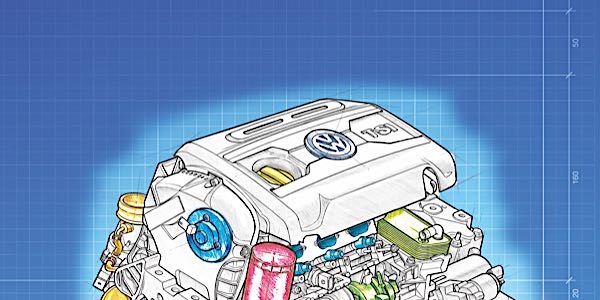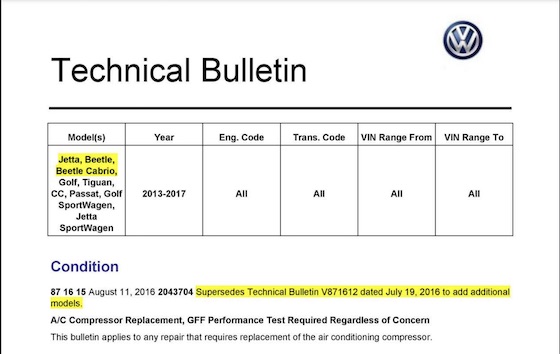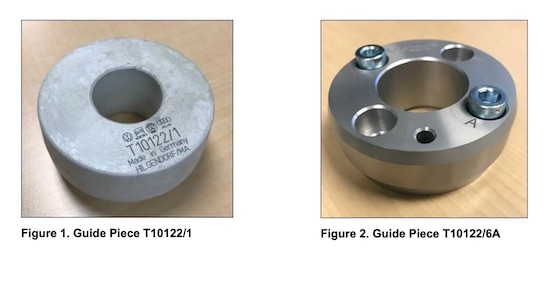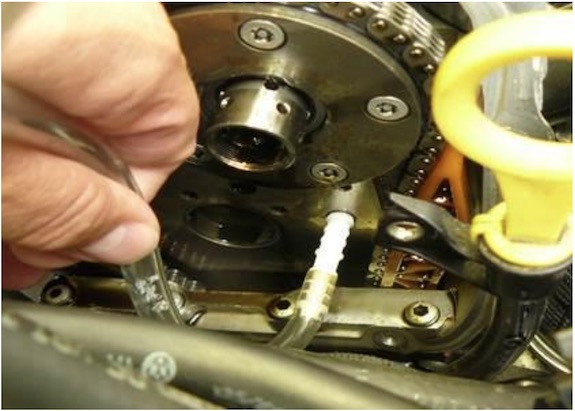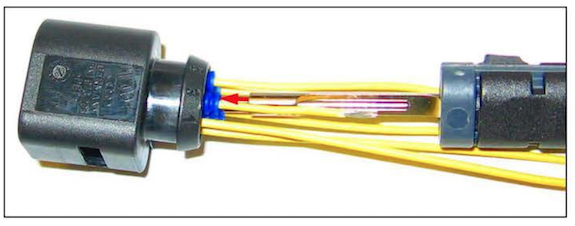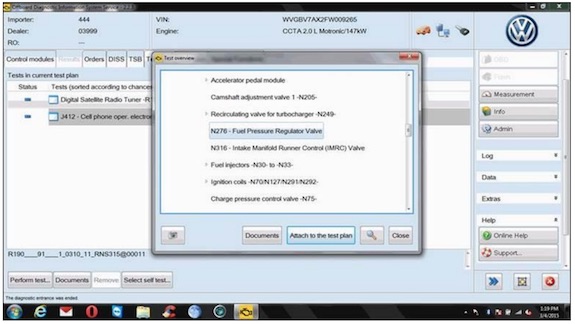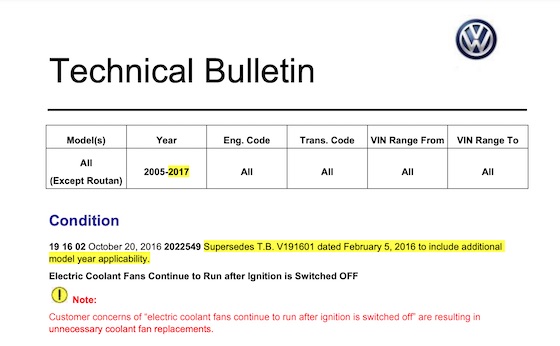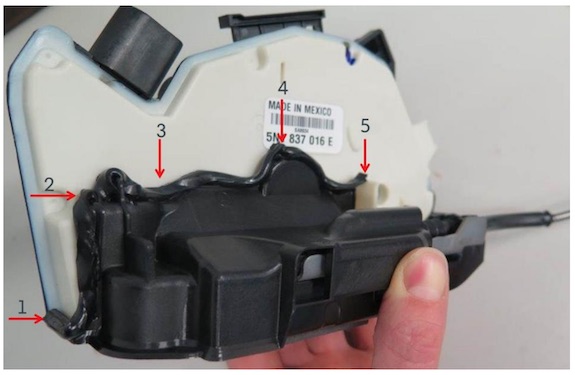Every year, Volkswagen issues hundreds of Technical Service Bulletins (TSBs) covering everything from sunroof leaks to new oil specifications. TSBs are communication tools provided to help technicians address problems in the field and to expedite the repair process by arming them with brand-specific service information.
Below are some of the 10 best Volkswagen TSBs that can be used by independent repair shops and late-model VW models that are out of warranty.
1. Reflashing and Reprogramming
Models: All
One of the more common types of TSBs issued during the past three years has been for improvements to engine control modules and transmission control software. Some of these improvements go back as far as 2008 models. The majority of the TSBs address emissions problems related to the operation of the oxygen sensors and catalytic converter. As a rule, it is recommended that you make sure the Volkswagen you are working on has the latest ECM calibrations. The new calibrations can help to keep the check engine light off and prolong the life of the converters or cure misfire codes.
Volkswagen also has multiple software updates for the DSG gearbox. The new software can improve shift quality, resolve hesitation and reduce clutch noise problems. Checking for these software updates before replacing the clutch or gearbox can help to repair the vehicle right the first time.
2. 1.8L and 2.0L Rear Main Seal Installation
Bulletin #13-17-02 (2044350)
Models: Volkswagen models with the 1.8L and 2.0L turbocharged gasoline engines manufactured between 2008-‘17.
This informational TSB covers the proper orientation of the seal’s flange for the rear main seal. The sealing lip needs to be facing toward the engine block. If the seal is not properly seated, it can cause a leak as soon as the car is started. It is easy to install the seal in reverse. VW recommends using the correct seal driver tool so the seal is at the correct depth.
3. 2.0L CCTA P0016 Code For Camshaft Position Sensor Caused by Blocked Passage
Models: 2009-‘17 models with the 2.0L CCTA or CBFA Engine
This TSB addresses problems with the non-return valve for the variable valve timing actuator oil supply. The strainer for the valve can be damaged and cause it to remain open. The open valve causes the oil in the actuator to bleed out.
When the engine is started or running at lower engine speeds, the engine is not able to actuate the camshafts and the code is set in the ECM. The fix is to remove the strainer. There are two types of strainers with different removal processes that are outlined in the TSB.
This TSB includes testing procedures and methods to remove the strainer, which involve applying pressure to the non-return valve and measuring the decay. If the valve does not hold pressure, it should be replaced.
4. 2.0L Intake Manifold Fixes for Codes P2004, P2014 and P2015
Bulletins #24-17-04 and #24-17-05
Models: 2006-‘16 2.0L engines (BPY, CCTA and CBFA)
These two TSBs cover improved parts for the intake manifold on 2.0L turbocharged engines. The improved solenoid valve for the intake manifold flap that regulates fresh air into the engine can become worn or clogged with debris.
This blockage will cause codes P2004, P2014 and P2015. This TSB also covers methods to test if the valve is worn using a scan tool to measure manifold vacuum pressure.
5. Sporadic Throttle-By-Wire Codes Cured With the Use of New Terminals
Bulletin #01-17-05
Models:
• 2006-‘08 – Jetta, Rabbit, GTI, Passat and EOS with the 2.0L BPY engine.
• 2008-‘09 – All with the 2.0 CCTA and CBFA engine
This TSB covers how to resolve the following DTCs:
P1545: Throttle Valve Control System Malfunction
P0121: Throttle/Pedal Position Sensor/Switch A Range Performance
P0123: Throttle/Pedal Position Sensor/Switch A Circuit High
P0221: Throttle/Pedal Position Sensor/Switch B Range Performance
P0222: Throttle/Pedal Position Sensor/Switch B Circuit Low
The fix to resolve these throttle-by-wire DTCs is to replace the terminals in the connector housing on the wiring harness that connects to the throttle body. This TSB shows how to stagger the splices to reduce strain on the harness.
6. Direct Fuel Injection High- and Low-Pressure Pump Diagnostics
Models: 2008-‘15 models with the 2.0L CCTA and CBFA engine
This is a must-read TSB for any technician who is working on vehicles with direct fuel injection. This bulletin covers how to diagnose a no-start or long-crank condition after the vehicle has been parked for a long period. The bulletin also discusses rough running issues and DTC P0087 for low fuel pressure.
It also outlines how to use scan tool data and a bi-directional test to determine if the source of the problem is the low-pressure pump in the tank or the high-pressure fuel pump on the engine.
If you are about to throw an expensive high-pressure fuel pump on a vehicle, you need to read this TSB first.
7. Cooling Fan Operation
Models: 2005-’17, all models
This two-page TSB covers cooling fan operation and how long the fans can run after the ignition is turned off. The bulletin states that the fans can run for up to 15 minutes after the ignition is turned off for gasoline engines and 16 minutes for diesel engines.
8. Oil Specifications
Bulletin for the oil list.
Models: All
Almost every year, Volkswagen issues a TSB regarding oil specifications for its vehicles. The first time this TSB was issued was in 2008 to ensure oils met the VW 502 specification. The TSB list brands of oil by weight and what VW standard they meet for both gasoline and diesel engines. The only update this year was for additional oil brands and weights.
The TSB recommends that owners always carry a spare quart of oil that meets the standards in the event the engine oil level needs topping off while they are on the road.
For the past decade, Volkswagen has been warning shops and consumers that substandard oils could cause damage to the engine and catalyst and that low-quality oils could cause damage to the high-pressure fuel pump lobes on the camshaft and the plunger on the pump.
9. Coolant Quality and Mixing
Models: All 1994-2016 (except Routan)
This TSB covers coolants G11, G12, G12+ and G12++ and their replacement with G13 coolant. This bulletin can help you identify the different coolant types by color and what different coolant mixes look like. Photos in the TSB show the color of each type of engine coolant (see page 50). The adjacent table shows the compatibility of the different coolants.
G12+, G12++ and G13 coolants are lifetime coolants when used exclusively in the coolant system.
The TSB advises that coolants can be mixed when adding/topping off fluid levels, as described in the table, but it is always a best practice to change the coolant due to reduced corrosion protection when coolants are mixed.
When the coolant is changed due to a cooling system issue, or if the incorrect fluid is being used, the cooling system should be drained and filled with the correct coolant.
You can read the table by identifying the factory-filled coolant at the top and comparing it to the available service coolants to the left (see page 48). (Example: If the car was factory filled with G12++, the allowable coolant is G12++ or G13.)
If a vehicle is found to have the incorrect coolant, the cooling system should be drained and then filled with the correct coolant.
10. Door Can’t Close or Open Due to Leak
Models: 2009-’17 Golf/GTI; 2015-’17 Golf R; 2011-’17 Jetta; 2012-’17 Passat and 2010-’17 Tiguan
TSB #57-17-01 is an interesting one that covers a condition that is familiar to drivers in the North — frozen doors. This TSB covers a large population of vehicles that have the actuator for the locks mounted in the front door on the striker plate. Water can leak into the actuator and freeze. When temperatures drop below 32º F, it can prevent the door from closing, locking or unlocking.
The cure is to remove the unit and install six-inch butyl sealing cord around strategic areas of the mechanism to prevent water intrusion.

